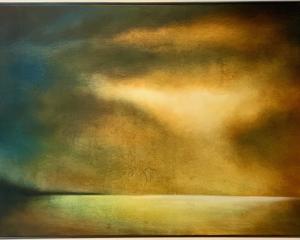Laura Elliott looks at exhibitions by Hannah Kidd, Garry Currin, and Megan Huffadine in this week's Art Seen.

Looking through the windows of Milford Galleries Queenstown, you might encounter the pink-tongued exuberance of a curious puppy, standing on his hind legs to peer through the glass, or you might instinctively step back from the menacing stare of a watchful wolf, standing guard over the creatures within - or perhaps caught on the hunt.
Woolf is so very realistic that it seems unwise to place him in such close proximity to the joyfully oblivious zebra, Zig Zag, or the multitude of mischievous puppies.
In Two Fish, One Scoop, the gentleman waiting for his fish and chips has discarded his muddy boots to stand in his socks. The picture of laid-back patience, he's so adeptly wrought that his metal chest seems to rise and fall as he stands quietly, lost in thought.
Kidd never attempts to hide the material from which she crafts; if anything, she emphasises the nuts and bolts of the works, drawing attention to the joins and scars.
But what she does with corrugated iron is nothing short of remarkable: in every nuance, line and curve, her creations seem to burst and breathe with life.
Kidd's work is a statement on the land, on rural life, the New Zealand ideal, and our dangerous habit of taking it for granted and exploiting it for profit; it's effective and brilliant, gently hammering home the message through sheer, approachable charm.
''Fantastic Land'' is her strongest exhibition yet, and is not to be missed.

Garry Currin's landscapes are not recognisable sights from a peaceful Sunday drive or a scenic holiday. Rather, they seem like fragmented images from dreams, imagination and mythology, pieced together with the slight blur of uncertain recollection.
Currin's technique of mixing strong clarity and detail with hazy abstraction keeps the eye in a constant state of motion, trying to find a stable point on which to focus.
The collection combines huge canvases with much smaller works on cuts of distressed metal, and the three largest paintings battle for the viewer's attention. Each piece is dramatically energetic, giving an illusive, hypnotic sense of movement.
The foreground water in Conversations with the Moon I, so realistic you feel you could drag a hand through the waves and feel the cold, gives way to shadowed land and the ghostly outline of the horizon in the mist.
There is something almost familiar about the terrain, but just slightly unearthly, slightly unsettling. The remote chill of Conversations goes to the opposite extreme in the apocalyptic, fiery Magma, where the central pit of flames seems to be encroaching on the surrounding land, dragging everything into its destructive force and igniting the surface with an ash-streaked, orange glow.
Likewise, the forces of nature swirl violently from the centre of Conversations with the Moon II, as turbulent waters collide from multiple directions into a turbulent whirlpool.

Megan Huffadine's signature style focuses on iconography and visual language, the ways in which we record and recall history, memories, and geographical locations.
The ``cairn'' is one such emblem, traditionally a pile of stones, used to point the way on a journey, to mark a burial site, or as part of a spiritual ceremony.
Her new exhibition looks at that ritual of creating a visual reference as a form of commemoration, which we continue to adapt in everyday life.
Huffadine considers both the enduring and fleeting nature of markers - ``the permanency of stone and metal alongside the ephemeral roadside shrines made of plastic windmills, flowers and grief'' - but also the way they become part of the landscape in which they are placed and the way we react to them.
The works themselves look like museum artefacts, like memory boxes, like tribal treasures. The use of colour - the palette restricted to earthy red, yellow and brown tones in one piece, and blues and greys in another - evokes the idea of dirt, dust and mountains, or of sea and sky, in a way that is more resonant than an exact representation.
Towering layer upon layer of symbols invites the viewer to make emotional connections for themselves, to see a shape and let a thought or a memory be triggered.
The insertion of a sculptural emblem in a display slot seems to ground each work, as if stating that here is the marker and above is an entire language of connected icons.












!["Flux" featuring Portraits of Geoff Dixon (2021–2025), acrylic on paper [installation view], by...](https://www.odt.co.nz/sites/default/files/styles/odt_landscape_small_related_stories/public/story/2025/07/1_macleod.jpg?itok=2n5TYmHs)